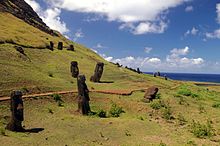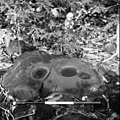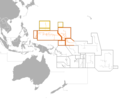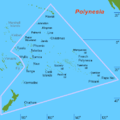Portal:Oceania
The Oceania PortalOceania (UK: /ˌoʊsiˈɑːniə, ˌoʊʃi-, -ˈeɪn-/ OH-s(h)ee-AH-nee-ə, -AY-, US: /ˌoʊʃiˈæniə, -ˈɑːn-/ OH-shee-A(H)N-ee-ə) is a geographical region including Australasia, Melanesia, Micronesia, and Polynesia. Spanning the Eastern and Western Hemispheres, at the centre of the water hemisphere, Oceania is estimated to have a land area of about 9,000,000 square kilometres (3,500,000 sq mi) and a population of around 44.4 million as of 2022. When compared to the continents (which it is often compared to, not including Australia), Oceania is the smallest in land area and the second-least populated after Antarctica. Oceania has a diverse mix of economies from the highly developed and globally competitive financial markets of Australia, French Polynesia, Hawaii, New Caledonia, and New Zealand, which rank high in quality of life and Human Development Index, to the much less developed economies of Kiribati, Papua New Guinea, Tuvalu, Vanuatu, and Western New Guinea, while also including medium-sized economies of Pacific islands such as Fiji, Palau, and Tonga. The largest and most populous country in Oceania is Australia, and the largest city is Sydney. Puncak Jaya in Highland Papua, Indonesia, is the highest peak in Oceania at 4,884 m (16,024 ft). The arrival of European settlers in subsequent centuries resulted in a significant alteration in the social and political landscape of Oceania. The Pacific theatre saw major action during the First World War with the Japanese occupying many German territories. During the Second World War, Allied powers the United States, Philippines (a U.S. Commonwealth at the time) and Australia fought against Axis power Japan across various locations in Oceania. (Full article...) Selected geographic article -Easter Island (Spanish: Isla de Pascua [ˈisla ðe ˈpaskwa]; Rapa Nui: Rapa Nui) is an island and special territory of Chile in the southeastern Pacific Ocean, at the southeasternmost point of the Polynesian Triangle in Oceania. The island is most famous for its nearly 1,000 extant monumental statues, called moai, which were created by the early Rapa Nui people. In 1995, UNESCO named Easter Island a World Heritage Site, with much of the island protected within Rapa Nui National Park. Experts disagree on when the island's Polynesian inhabitants first reached the island. While many in the research community cited evidence that they arrived around the year 800, a 2007 study found compelling evidence that they arrived closer to 1200. The inhabitants created a thriving and industrious culture, as evidenced by the island's numerous enormous stone moai and other artifacts. But land clearing for cultivation and the introduction of the Polynesian rat led to gradual deforestation. By the time of European arrival in 1722, the island's population was estimated to be 2,000 to 3,000. European diseases, Peruvian slave raiding expeditions in the 1860s, and emigration to other islands such as Tahiti further depleted the population, reducing it to a low of 111 native inhabitants in 1877. (Full article...)Related portalsSelected article -Indo-Fijians (Fiji Hindi: फ़िजी के हिंदुस्तानी, romanized: Fiji ke Hindustani), also known as Indian Fijians (also colloquially known as "Findians" or "Findus"), are Fijian citizens of Indian descent, and include people who trace their ancestry to various regions of the Indian subcontinent. Although Indo-Fijians constituted a majority of Fiji's population from 1956 through the late 1980s, discrimination and the resulting brain drain resulted in them numbering 313,798 (37.6%) (2007 census) out of a total of 827,900 people living in Fiji . Although they hailed from various regions in the subcontinent, the vast majority of Indo-Fijians trace their origins to the Awadh and Bhojpur regions of the Hindi Belt in northern India. Indians in Fiji speak Fiji Hindi also known as ‘Fiji Baat’ which is based on the Awadhi dialect with major influence from Bhojpuri. It is a koiné language with its own grammatical features, distinct to the Modern Standard Hindi spoken in India. The major home districts of Fiji's North Indian labourers were Basti, Gonda, Lucknow, Kanpur, Faizabad, Ballia, Ghazipur, Gorakhpur, Sultanpur, Siwan, Shahabad, Saran, and Azamgarh, in the present-day Awadh region of Uttar Pradesh and the present-day Bhojpur region of Uttar Pradesh, Bihar and Jharkhand. Others (in a smaller quantity) originated in the Telugu and Tamil regions. A small contingent of indentured labourers came from Afghanistan and Nepal. A small amount of free immigrants also came from Gujarat and Punjab. Many of the Muslim Indo-Fijians also came from Sindh and various other parts of South Asia. Fiji's British colonial rulers brought South Asian people to the Colony of Fiji as indentured labourers between 1879 and 1916 to work on Fiji's sugar-cane plantations. (Full article...)Did you know -
General images -The following are images from various Oceania-related articles on Wikipedia.
TopicsSubcategoriesThings you can doAssociated WikimediaThe following Wikimedia Foundation sister projects provide more on this subject:
In other languagesWikipedia in other languages used in Oceania:
More portals |







































































